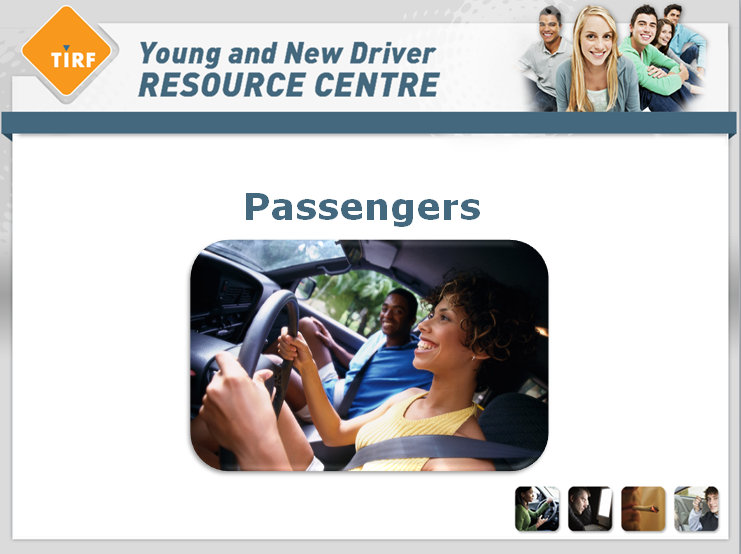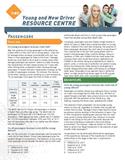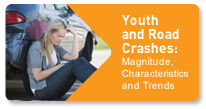The Issues - Passengers
| Video coming soon
Program:
Agency: |
Downloads

PowerPoint

Factsheet |
DEFINITION
Do young passengers increase crash risk?
Do all passengers increase crash risk for young drivers?
BEHAVIOURS
How do young passengers increase the crash risk of young drivers?
When do passengers increase crash risk?
How many passengers die due to alcohol-related young driver crashes?
Who is most likely to ride with a young impaired driver?
ATTITUDES, CONCERNS AND PERCEPTIONS
What do young drivers think about young passengers?
LEGISLATION
Are there specific laws for young drivers about passengers?
SOLUTIONS
How do we reduce the crash risk of young drivers with passengers?
What programs are available which support passenger restrictions?
REFERENCES
DEFINITION
Do young passengers increase crash risk?
Yes. The presence of young passengers in the vehicle has a direct effect on the crash risk of young drivers. Crash risk for teenage drivers increases incrementally with one, two, three or more passengers by three to five times.1 Teenage drivers are more likely to be at fault in crashes when other teenage passengers are present.2 Below is a table showing the characteristics of fatal crashes among 16-17 year olds when driving alone compared to when carrying teenage passengers. It reveals that each characteristic increases as the number of passengers increases. For instance, the chances of the driver making an error resulting in a crash increases by 7% as passenger count goes from two to three or more.
|
Driver Alone |
One passanger |
Two Passangers |
Three or more passangers |
Driver error |
71% |
75% |
78% |
85% |
Speeding |
30% |
34% |
42% |
46% |
Single vehicle |
41% |
45% |
57% |
69% |
Killed with positive BAC |
12% |
15% |
12% |
16% |
The death rate for 16-19 year old passengers in vehicles is higher than any other age group. The death rate for passengers 16-19 years old is 9.3 deaths per 100,000 population. Older age groups have a death rate of 3 deaths per 100,000 population. Between 70% and 74% of 16-17 year old passengers who die in car crashes are with drivers who are teenagers.3
Do all passengers increase crash risk for young drivers?
No. For the most part, it is teen passengers who increase the crash risk for teen drivers. Young male passengers pose the greatest danger to young drivers. The presence of one young male passenger almost doubles the death rate for both male and female drivers and two or more young male passengers more than doubles young driver death rates.
Conversely, passengers who are children (under twelve) or adults (25 years or older) have a protective effect on young drivers. Instead of the crash rate increasing, the presence of these passengers decreases the crash rate of young drivers.4 This could be due to the fact that young drivers want to protect child passengers (they could be siblings, nieces or nephews, or their own children) and are more aware that causing a fatal crash would have serious implications for children in the vehicle. Being accompanied by an adult (a parent, uncle, or some one of authority) can prevent young drivers from taking risks while driving to avoid getting in trouble, disappointing their elders and having car privileges taken away.
Passengers of any age also have a ‘protective effect’ on older drivers5 and drivers aged 30 to 59 actually have lower death rates when passengers are present.6
1 Williams et al. 2002
2 Preusser et al. 1998
3 Williams et al. 2007
4 Williams et al. 2007
5 Engstrom et al. 2008
6 Chen et al. 2000
Back to Top
BEHAVIOURS
How do young passengers increase the crash risk of young drivers?
Passengers can distract drivers (e.g, talking to them, turning up music), encourage them to take risks (e.g., tell them to speed through a red light, take a sharp turn) or can interfere physically with the operation of the vehicle (e.g., play fighting, covering the driver’s eyes, grabbing the wheel).
The presence of teen passengers can encourage young drivers to show off, regardless of whether they actually tell a driver how to drive. Teenagers have a high need for social acceptance and are sensitive to the behaviour of peers. Due to their inexperience handling peer pressure they are much more prone to being influenced. Peer influence commonly leads to risk taking on the part of the driver because this is the type of behaviour expected in the social driving environment.7
For instance, males are almost six times more likely to perform an illegal manoeuvre in the presence of peer (usually male) passengers.8
Young drivers can be particularly distracted by passengers of the opposite sex because of the importance of romantic relationships at this stage in their lives. A boyfriend or girlfriend in the car may make the driver nervous or provoke them to drive in ways to ‘impress’ their significant other. For example, aggressive driving among males is three times higher when female passengers are present than when driving alone. This might be due to the fact male drivers want to appear tough or strong in front of females and attempt to do so by being aggressive on the road,9 which in turn places young female passengers at a higher risk.
When do passengers increase crash risk?
Increased crash risk due to the presence of passengers is the same during the day as it is during the night but the overall crash risk of young drivers is highest at night.
Young drivers are more likely to have been drinking when there are three or more passengers in the vehicle10 and two or more teenagers are present with the driver in 37% of night- time crashes. Risky driving seems to be most associated with driving for recreational purposes (e.g., out with friends for the night).11 It can be assumed that night-time driving brings with it alcohol, social events, and carloads of teens needing to get home at the end of the night, likely not wearing their seatbelts. Thus, driving at night with several passengers after alcohol consumption is an extremely dangerous combination for young drivers.12
How many passengers die due to alcohol-related young driver crashes?
Studies show that riding with an impaired driver is a common behaviour among young people.13 Out of a sample of high school students with a mean age of 15 years, 23% reported that they would ride with an impaired driver. University students are even more likely to accept a ride with a driver who has been drinking; 57% surveyed admitted they would do so.14 Passengers account for about 22% of persons killed in alcohol-related crashes and more than 88% of passengers killed in alcohol-related crashes were with a drinking driver. For passengers aged 16-24 years, this number was closer to 97%.15
Who is most likely to ride with a young impaired driver?
Riding with an impaired driver is most common among youth who live in rural areas, have either a single parent or no parent, have a lower income, and a lower level of education. Traits such as being rebellious and impulsive also lead to a higher likelihood of riding with an impaired driver. Those who use public transportation are less likely to get in a vehicle with a driver who has been drinking or taken drugs, and conversely, those who prefer private vehicles for transportation are more likely to ride with an impaired driver. Both males and females have similar rates of riding with impaired drivers.16
Drivers who drive impaired themselves are much more likely to get in a car with an impaired driver. This may be because their experiences while driving impaired did not have negative consequences (e.g., crashing, getting arrested) and they assume they will have the same outcome being a passenger with an impaired driver. As well, passengers who are driving with impaired drivers are likely as impaired as the driver which affects their judgment and can cause them to make unsafe choices.17
7 Williams et al. 2007
8 Curry et al. 2011
9 Curry et al. 2011
10 National Safety Council 2007
11 Preusser et al. 1998
12 Williams et al. 2002
13 Marcoux et al. 2010
14 Calafat et al. 2009
15 Transport Canada 2008
16 Calafat et al. 2009
17 Cartwright and Asbridge 2011
Back to Top
ATTITUDES, CONCERNS AND PERCEPTIONS
What do young drivers think about young passengers?
Almost half of the teenagers surveyed in an American study admitted that having young peers in their vehicles had a distracting effect. Similarly, 44% of the student respondents thought they were safer drivers without their friends in the vehicle.18
In a focus group conducted in the United States, teens were asked how they felt about having friends in the car while they were driving. Respondents acknowledged that passengers are dangerous for several reasons. They knew that as drivers they were more likely to show off in front of friends. They reported instances where friends had tickled them, covered their eyes, encouraged them to speed, to chase someone or to do a stunt (e.g., a ‘donut’), and shouted sudden orders at them such as “turn here quick”. Teens recognized that all these behaviours were dangerous because they affect driving concentration. However, they also felt that after a few months they were experienced enough to handle their passengers. In addition, they did not agree with the passenger restrictions of graduated driver licensing (GDL) programs because they “put more teens on the road in separate cars”. Teens felt passengers were beneficial as an extra pair of eyes to identify road hazards or to help with directions. Instead, the focus group suggested teen drivers should have the confidence to impose rules on their passengers in order to prevent them from causing any distractions.19
18 Williams et al. 2007
19 NHTSA 2006
Back to Top
LEGISLATION
Are there specific laws for young drivers about passengers?
All provinces and most territories have GDL programs that have certain requirements for drivers to get their licence. Most of these programs have included passenger restrictions. This means that drivers at a certain stage in the program can only carry a limited number of young passengers in their vehicle, especially during specific time periods. For instance, in Ontario, for the first six months of the unsupervised licence stage, and if the driver is under the age of 19, they are only allowed one passenger in their vehicle between midnight and 5 a.m. In British Columbia, unless the driver is accompanied by some one 25 years or older, they can only have one passenger during the unsupervised licence stage. To see all Canadian GDL program level one restrictions, including passenger restrictions, please go to: https://yndrc.tirf.ca/downloads/YNDRC-ataglanceGDLpass-learnerstage1-3.pdf.
Back to Top
SOLUTIONS
How do we reduce the crash risk of young drivers with passengers?
GDL programs should extend passenger restrictions to include day-time hours as well. Studies show that passengers pose as much risk during the day as they do at night, so extending restrictions from night-time hours into daytime hours would be beneficial. For instance, before GDL programs began, of all fatal crashes of 16-17 year olds who were transporting passengers under the age of 20, only 11% occurred between midnight and 5 a.m. (common period of passenger restrictions).20
The use of passenger restrictions only at night limits the effectiveness of GDL programs by not addressing an important high risk crash period for young drivers.
It is important that parents are actively involved in ensuring GDL passenger restrictions are followed by young drivers.21 If rules are not enforced by family or guardians then it is much less likely that young drivers will respect these restrictions. Parents should know that GDL programs have been found to reduce 30% of passenger injuries and deaths,22 meaning that enforcing restrictions helps to keep teen drivers safe. Parents can also play a role by knowing the friends of their young driver and who is riding in the young driver’s car. Studies show that youth are less likely to get in a car with an impaired driver if they are out with friends who their parents have met and trust.23
What programs are available which support passenger restrictions?
Not many initiatives have been developed explicitly to support passenger restrictions. This is likely because these measures are newer additions to GDL programs in Canada. Countries overseas, on the other hand, have been using these restrictions since the late 1980s, and have developed some slogans to promote the cause. The Norwegian Public Roads Administration developed the “Speak Out” program in 1993 which targeted teenagers aged 16 to 19 and encouraged teenage passengers to speak out if the driver they are with is driving dangerously. The message is that teens should have confidence to stick up for their safety, regardless of peer pressure. Studies found this program to be effective and meaningful to targeted teens.24
The Transport Accident Commission in Melbourne, Australia developed the “If you don’t trust the driver, don’t get in” campaign in 1997. The goal of this campaign was to raise awareness that young passengers have the decision as to whether or not to get into a vehicle with a potentially irresponsible driver. It also highlights the potential consequences (death of a passenger) if a young driver chooses to drive dangerously while some one has trusted them to get them home safely. This initiative may have been misconstrued as a message against drunk driving.25 More programs to support the positive benefits of passenger restrictions would be beneficial.
20 Chaudhary 2007
21 National Safety Council 2007
22 Chaudhary 2007
23 Calafat et al. 2009
24 Regan and Mitsopoulos 2001
25 Regan and Mitsopoulos 2011
Back to Top
REFERENCES
Calafat, A., Adrover-Roig, D., Blay, N., Juan, M., Bellis, M., Hughes, K., Mendes, F., Kokkevi, A. (2009). Which young people accept a lift from a drunk or drugged driver? Accident Analysis and Prevention. 41, 703-709.
Cartwright, J. Asbridge, M. (2011). Passenger’s decisions to ride with a driver under the influence of either alcohol or cannabis. Journal of Studies on Alcohol and Drugs. 72(1), 86-95.
Chaudhary, N.K., Williams, A.F., Nissen, W. (Septermber 2007). Evaluation and Compliance of Passenger Restrictions in a Graduated Driver Licensing Program.
National Highway Traffic Safety Administration. DOT HS 810 781. U.S Department of Transportation. Washington, DC.
Chen, L., Baker, S. P., Braver, E. R., Li, G. (2000) Carrying Passengers as a Risk Factor for Crashes Fatal to 16- and 17-Year-Old Drivers, JAMA, Vol. 283, pp. 1578–1582.
Curry, A. E., Mirman, J.H., Kallan, M.J., Winston, F.K., Durbin, D.R. (2011). Peer Passengers: How Do They Affect Teen Crashes? Journal of Adolescent Health. In Press.
Engstrom, I., Gregersen, N.P., Granstrom, K., Nyberg, A. (2008). Young drivers –Reduced crash risk with passengers in the vehicle. Accident Analysis and Prevention. 40(1), 341-348.
Marcoux, K., Robertson, R., Vanlaar, W. (2010). The Road Safety Monitor 2010: Youth Drinking and Driving. Traffic Injury Research Foundation. Ottawa, Canada.
National Highway Traffic Safety Administration (NHTSA). (September 2006). Teen Unsafe Driving Behaviours: Focus Group Final Report. DOT HS 810 670. U.S Department of Transportation. Washington, DC.
National Safety Council. (2007). What you should know about… Passenger Restrictions. Factsheet: Graduated Driver Licensing. International Symposium on Novice Teen Driving: GDL and Beyond – Research Foundations for Policy and Practice. Tucson, Arizona. Retrieved from: http://www.nsc.or g/safety_road/TeenDriving/Documents/7-9500PassengerRestrictions.pdf
Preusser, D.F., Ferguson, S.A., Williams, A.F. (1998). The Effect of Teenage Passengers on the Fatal Crash Risk of Teenage Drivers. Accident Analysis and Prevention. 30(2), 217-222.
Regan, M.A., Mitsopoulos, E. (2001). Understanding Passenger Influences on Driver Behaviour: Implications for road safety and recommendations for countermeasure development. Accident Research Centre. Monash University. Report #: 180.
Transport Canada. (2008). A quick look at alcohol-related crashes in Canada. Fact Sheet TP 2436E - RS-2008-09, November 2008. Ottawa, Ontario, Canada: Road Safety and Motor Vehicle Regulation Directorate, Transport Canada. Retrieved from: http://www.tc.gc.ca.proxy.bib.uottawa.ca/eng/roadsafety/tp-tp2436-rs200809-menu-397.htm
Williams, A.F., Ferguson, S.A., McCartt, A.T. (2007). Passenger effects on teenage driving and opportunities for reducing the risks of such travel. Journal of Safety Research. 38(4), 381-390.
Williams, A.R., Ferguson, S.A. (2002). Rationale for graduated licensing and the risks it should address. Injury Prevention. 8, ii9-ii16.
Back to Top
Last updated February 2014





